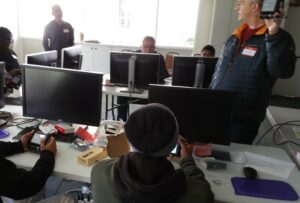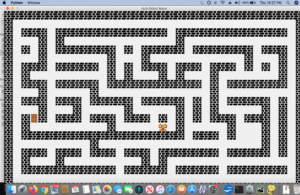
Happy New Year! We hope 2021 begins a good year for you.
This is Hope IT’s fifth year. We had our share of difficulties and missteps, but God showed us the kids are well worth the effort. That gives us purpose, and keeps us going.
In past newsletters, we focus mostly on our courses. In these next few newsletters, we’ll focus on our people…both our Hope IT team members and some of our students.
In this newsletter, I would like to spotlight our Hope IT Technical Director, Mark Bracher, who has the final say on what technology we use and teach. Mark was the very first person to join the team, 5 ½ years ago. I have known Mark for 25+ years…losing count now. Back then, Mark and I lived in the same house with 4 to 6 other guys, all working in either the junior high or high school ministry of our church across the street, in Highland Park. Mark is kind, generous, honest and humble.
We are old friends. We both graduated in Mathematics from Occidental College in Los Angeles (Eagle Rock). He, my wife Ruth, our friend David (Mark’s best man in his wedding), and I played many board games. He was one of our Scripture readers at Ruth and my wedding. Mark helped Ruth and I move into our first home in Altadena. Mark is technical, and uses that creatively. For example, he brews his own beer. He has a sign in his dining room now, a gift from his friend David: “Beer, so much more than a breakfast drink.”
Mark has always been a professional programmer. I know very few better engineers. Originally he intended to be a math professor, so math comes up in our Hope IT courses. Here are two examples of courses Mark created.
Our course in February 2019 was to create cameras out of Raspberry Pis. Getting the idea from RedHat’s presentation at the Linux EXPO, SCaLE, Mark used his personal 3D printers to print the cases for the cameras. Getting it right took many tries. It had to have the right holes for monitor cables and the other cables, fit the small touch screen, and hold the Raspberry Pi inside. It takes 8 hours to print a camera case. After several iterations, he created 8 camera cases for the Hope IT course. In the top picture he is showing our students how to fit everything inside. On the 3rd Saturday of the course, we walked the students around CalTech, taking pictures with their newly built cameras. Most of the pictures on our web site are from that Raspberry Pi course.
For our course in February 2020, Mark created (in Python) the maze and a robot to solve it. Students could control the robot in their Python code. If you think that was hard enough, Python isn’t even Mark’s top choice of programming languages. He also created the program to arbitrarily generate different mazes given a numerical seed, and of course, ones that are solvable, meaning there is an exit. (See a screenshot below of the maze application.) If you use the same seed, you get the same maze, to make the mazes identical and reproducible. Mazes can be small, medium, large, and robot speed is configurable. We post our source code on-line so others can benefit. (We try to do this for each course we offer.) After all this work, Mark was willing to co-teach this Python course with a new team member.
Mark is a gift to Hope IT. Mark and I are working on a Data Analysis course for this February. Mark and another Hope IT team member are working on a future robotic course in the future. We all have fun creating these courses, and teaching them.
Please pray for our students and our Hope IT team. God continues to move and work. We are fortunate to already see that occur.

